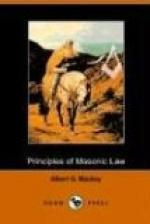“The Grand Lodge consists of, and is formed by, the Masters and Wardens of all the regular particular lodges upon record, with the Grand Master at their head, and his Deputy on his left hand, and the Grand Wardens in their proper places.”
From time to time, the number of these constituents of a Grand Lodge were increased by the extension of the qualifications for membership. Thus, in 1724, Past Grand Masters, and in 1725, Past Deputy Grand Masters, were admitted as members of the Grand Lodge. Finally it was decreed that the Grand Lodge should consist of the four present and all past grand officers; the Grand Treasurer, Secretary, and Sword-Bearer; the Master, Wardens, and nine assistants of the Grand Stewards’ lodge, and the Masters and Wardens of all the regular lodges.
Past Masters were not at first admitted as members of the Grand Lodge. There is no recognition of them in the old Constitutions. Walworth thinks it must have been after 1772 that they were introduced.[8] I have extended my researches to some years beyond that period, without any success in finding their recognition as members under the Constitution of England. It is true that, in 1772, Dermott prefixed a note to his edition of the Ahiman Rezon, in which he asserts that “Past Masters of warranted lodges on record are allowed this privilege (of membership) whilst they continue to be members of any regular lodge.” And it is, doubtless, on this imperfect authority, that the Grand Lodges of America began at so early a period to admit their Past Masters to seats in the Grand Lodge. In the authorized Book of Constitutions, we find no such provision. Indeed, Preston records that in 1808, at the laying of the foundation-stone of the Covent Garden Theatre, by the Prince of Wales, as Grand Master, “the Grand Lodge was opened by Charles Marsh, Esq., attended by the Masters and Wardens of all the regular lodges;” and, throughout the description of the ceremonies, no notice is taken of Past Masters as forming any part of the Grand Lodge. The first notice that we have been enabled to obtain of Past Masters, as forming any part of the Grand Lodge of England, is in the “Articles of Union between the two Grand Lodges of England,” adopted in 1813, which declare that the Grand Lodge shall consist of the Grand and Past Grand Officers, of the actual Masters and Wardens of all the warranted lodges, and of the “Past Masters of Lodges who have regularly served and passed the chair before the day of Union, and who continued, without secession, regular contributing members of a warranted lodge.” But it is provided, that after the decease of all these ancient Past Masters, the representation of every lodge shall consist of its Master and Wardens, and one Past Master only. There is, I presume, no doubt that, from 1772, Past Masters had held a seat in the Athol Grand Lodge of Ancient Masons, and that they did not in the original Grand Lodge, is, I believe, a fact equally indisputable. By the present constitutions of the United Grand Lodge of England, Past Masters are members of the Grand Lodge, while they continue subscribing members of a private lodge. In some of the Grand Lodges of the United States, Past Masters have been permitted to retain their membership, while in others, they have been disfranchised.




